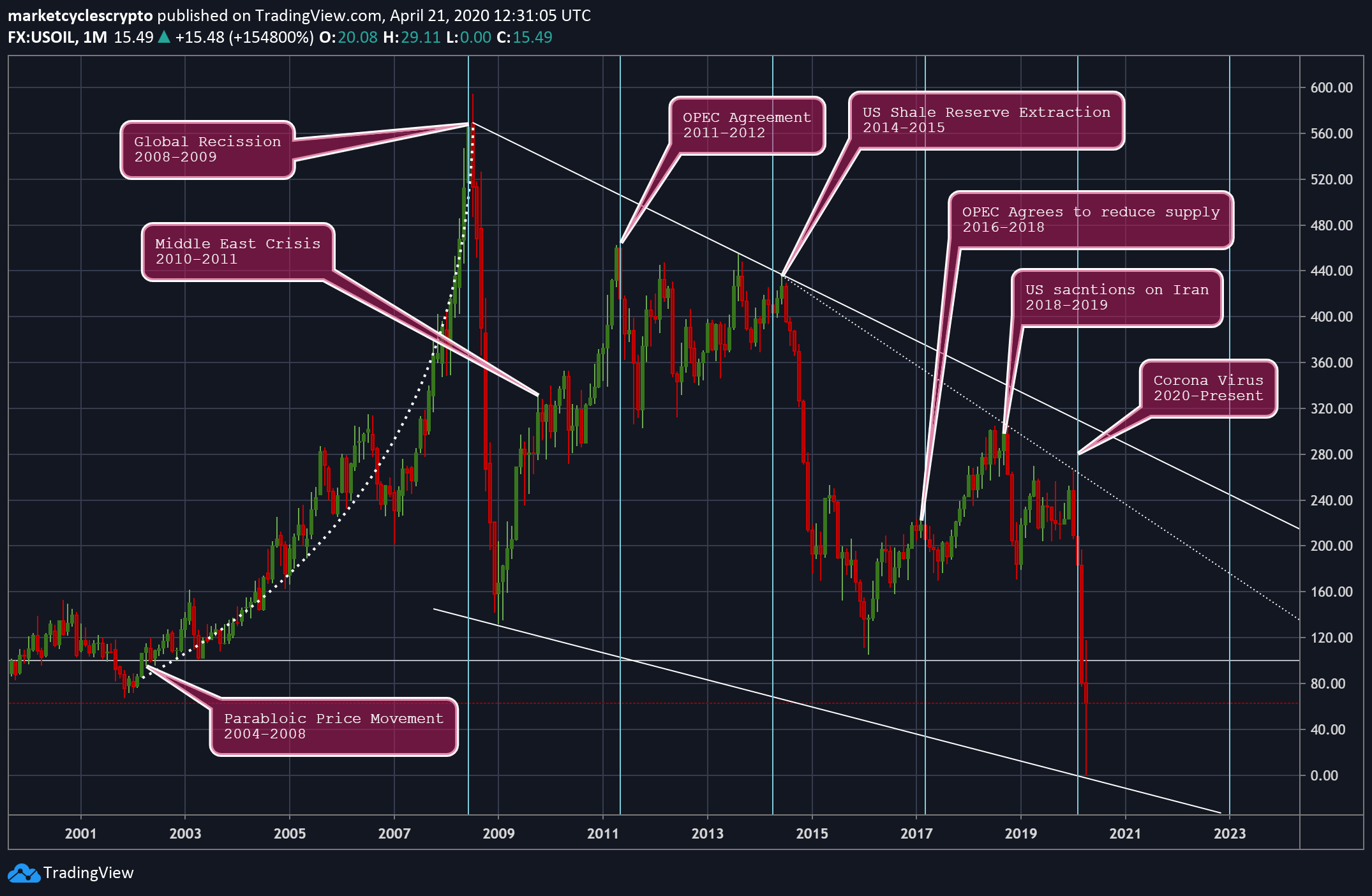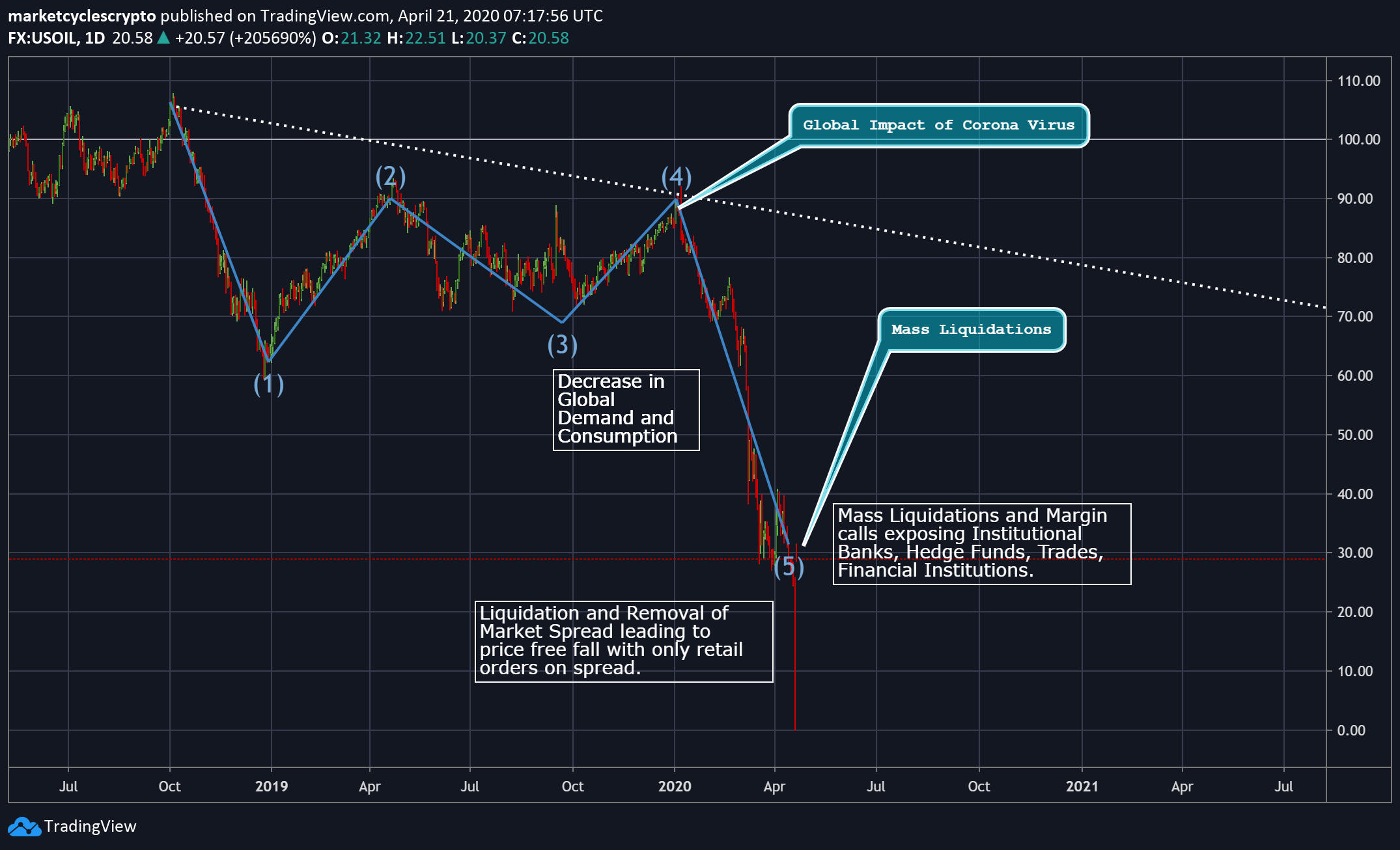Understanding the Market Structure of Oil and its Correlation with Bitcoin
The price of crude oil dropped below zero for the first time in history. With storage facilities filled to the brim and settlement of May futures contract on Tuesday, the price movement has shocked many. In this analysis, we study the recent history of oil, what drives it price and how it affects Bitcoin.


Market Highlights
-
The price of crude oil dropped below zero for the first time in history.
-
Sellers were paying buyers to make deliveries of crude oil in a move to evade the possibility of sustaining storage costs.
-
Demand for oil has reduced so much that all the storage facilities are at overcapacity with no interested buyers.
-
The downtrend of oil prices started in January after the Coronavirus outbreak and has only accelerated thereafter.
-
The low demand for Crude oil is due to various reasons such as the Travel and Aviation ban followed by half of the world currently living under lockdown.
Before understanding the market structure of the oil, we need to understand that the oil market is a highly manipulated market due to the personal and monetary interests of various stakeholders. Understanding human conflicts, geopolitics, and principles of extraction, storage, and demand are the prerequisites of understanding how the oil market works.
Market History of oil
2004-2008: The demand for crude oil increased after a sustained increase in demand from developing countries. This initiated a parabolic movement of oil's price as the demand outstripped the supply. Further, the OPEC nations were not interested in upgrading their extraction and storage facilities in order to bring the price of oil to an equilibrium.
2008-2009: The price of oil crashed due to a worldwide recession which reduced the demand for oil drastically and forced OPEC nations to take corrective measures.
2010-2011: The price of oil started increasing from 2010 after the Arab spring which increased political instability and caused fear in markets as the majority of the world's oil reserves were at high risk including Libya, Syria, Iran, Iraq, Egypt, etc. Further, the economic recovery and increase in demand from India and China for oil increase the price of the commodity.
2011-2012: The OPEC nations came to an agreement to extract more oil thereby increasing the supply in order to supplement the world demand and remove the fears of conflict that had spiraled out of control causing fear in the markets.
2014-2015: The USA started the extraction of shale reserves which reduced the price of oil significantly, pushing Venezuela into an economic meltdown coupled with hyperinflation and sanctions. Further, the OPEC started a price war by letting the price of oil fall hoping that the decline in price would make shale reserves extraction unprofitable leading US shale producers to shut down.
2016-2018: The OPEC agrees to cut its production output in a bid to prop up the price. Various OPEC nations were suffering a serious and dangerous downturn with high costs of extractions as compared to US counterparts, due to which they agreed to decrease the supply in order to reach a better equilibrium price.
2018-2019: USA and EU nations imposed sanctions on Iran thereby cutting off its exports and the demand for oil on the international market. Reducing and weakening the demand for oil from countries like India, China, Japan, Germany, etc.
2020-Present: The price of oil started collapsing from the month of January as international flights started to shutdown. With the aviation and traveling industry under restrictions the demand for oil reduced significantly. As the spread of the virus accelerated and nations all around the world went into lockdown with the suspension of domestic travel, the demand for oil saw a sharp decline, and storage facilities around the world found it difficult to store oil with no buyers in the market.

What led to the oil price crash?
1. The increase in inventory at the rate of 6-7 million barrels per week.
2. Cushing hub, where a majority of oil is stored saw its facilities completely filled.
3. Traders who were not able to take the delivery sold it on for the available prices.
4. The fall in price and the fear of May futures expiring on Tuesday ie, April 21 intensified the selling of oil.
5. The drop in price triggered mass liquidations and margin calls on various positions held by financial institutions, traders, etc, driving the price down even more.
6. Liquidation of positions also removes liquidity from the market spreads thereby accelerating the crash with poor liquidity on the books.

The correlation between Bitcoin and oil:
The correlation between Bitcoin and oil has always been to the minimum when compared to the correlation between oil and Equities where the correlation is as high as 80%.
Even though the correlation index between Bitcoin and oil is slow, both of the commodities have a similar market structure, where Bitcoin experienced a parabolic advance in 2017 due to an increase in media attention, due to the ICO rush. After that time, Bitcoin has largely been traveling in a downtrend channel breaking the momentum and rallying due to fundamental time to time.

Even though we know that Bitcoin halving is right around the corner, the technicals are indicating a steep downturn is possible with the RSI trending towards 0, which represents that the price is overbought and will trend downwards. BBands is also tightening and trending in towards a downward momentum. It is highly unlikely that the blockchain market will face an upturn where there is no economic recovery or rally in the world and people are living paycheck to paycheck. Even though Bitcoin halving is a strong fundamental what is happening around the world negates its benefits as Bitcoin is a high-risk asset class and investors are wary of taking any investment decisions when a global recession is right at the doorstep.
Further, it is highly unlikely that money from the equity markets and the oil market will move towards Bitcoin and other cryptocurrencies as the institutions are cutting down risk and taking what all they have. Furthermore, retail investors are also personally affected by the lockdown and allocating resources to Bitcoin and cryptocurrencies ignoring that they would need money in the coming months for survival is highly unlikely.
The analysis provided by the author is purely educational in nature and does not continue any legal, investment, financial, or trade advice. Please do your research before investing or taking any financial decision.
Image via Shutterstock
References:
[1] Institue for Environmental Diplomacy and Security, Basic Principles of Economics and Rising Oil Prices, James M. Jeffords Center, the University of Vermont, available at https://www.uvm.edu/ieds/node/468.
[2] A. Mudgill, What led crude oil prices fall below $0 a barrel, Economic Times, dated 22 April 2020.
[3] B. Pulmer, Oil prices keep plummeting as OPEC starts a price war with the US, Vox, dated 28 November 2014.
[4] T. DiChristopher, Oil Suffers its worst monthly drop in more than two years during ugly October for markets, CNBC, dated 31 October 2018.
[5] L. Elliot, Middle East Crisis may leave world over an Oil Barrel, The Guardian, dated 7 February 2011.
[6] J. Baffes et al, The great plunge in oil prices: Causes, Consequences, and Policy Responses, World Bank Group, dated March 2015, available at http://pubdocs.worldbank.org/en/339801451407117632/PRN01Mar2015OilPrices.pdf.
Image source: Shutterstock
